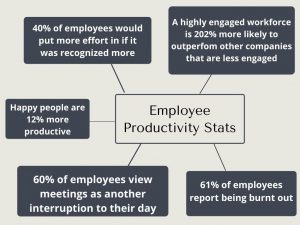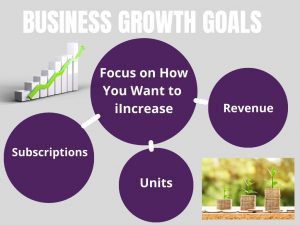As a small business owner, there are many things about your business that are in your control, and some that aren’t. How would you classify your employees’ productivity levels – as something you have control over? Or do you often feel like you’re at the mercy of outside forces when it comes to your employees working up to their potentials? It doesn’t have to be that way! And it doesn’t require raises or big gifts to get your employees producing more, higher quality work. All it takes is some good old fashioned people management skills, which we know you’ve got in spades!
What’s Holding Your Employees Back?
One important thing to remember is that employee productivity is not just about quantity, it’s also about quality. But before you can find that sweet spot of employees producing a lot of high quality work, you have to understand that many people these days can feel distracted and unmotivated at work. That’s understandable: we’re living (and working) in a world that is constantly connected and filled with distractions. Even the ability to have meetings anytime, anywhere can be an issue when it comes to productivity. In addition, many people now spend more time working than they do sleeping, making for a frustrating lack of work-life balance. Think about the following stats:
Think about the following stats:
- 70% of workers admit to feeling distracted while working, with 16% saying they’re almost always distracted
- The average employee is interrupted from their work 56 times a day, and spends an average of two hours a day recovering from interruptions!
- 60% of workers say they view meetings as another interruption to their day
- 66% of people say they would be better, more productive employees if they got more sleep
- 1 million workers miss work each day due to stress, with 31% feeling high levels of stress at work
- 61% of workers report being burnt out at their job
- 40% of employees say they would put more effort into their work if that effort was recognized more often
- 89% of workers prefer to work alone to hit their maximum productivity
- Happy people are 12% more productive
- Employees who feel that their voice is heard at work are 4.6 times more likely to perform at their best
- A highly engaged workforce is likely to outperform companies with less engaged workforces by 202%!
The above numbers might be eye-opening. It seems that employees are more likely to be distracted or stressed than they are to be engaged and feel heard – and that could be a huge problem for your business. But consider the positive numbers above, and know that there are ways to get your employees happier, more empowered, and more engaged so that you can see your productivity levels soar.
What It Means to Be Productive – and How to Get There
What does productivity mean in terms of your business? There are three criteria your team should be meeting:
- They get their work through all their work, generally meet all their deadlines, and don’t spend too much time on any one task.
- You are pleased with the quality of their work – it should at least meet, if not exceed, your expectations.
- Their time and efforts are spent in the right way, and not wasted on the little things.

To get your team to this point, try the following strategies:
- Make sure employees feel respected and understood – You need to understand your employees in more ways than one. Of course, you need to know their skill sets and match them to their tasks in order for them to be as productive as possible, but you also need to understand their motivations – what brings them to work everyday and what they need to feel supported. Let them know you see them, and that you respect their work and have their backs, no matter what.
- Set clear, focused goals and expectations – Your employees can’t be efficient if they’re not working toward a clear goal. And not only do goals need to be clearly defined, they also need to be achievable in order for your employees to stay on track and be productive. Try the S.M.A.R.T. goals method: set goals that are specific, measurable, attainable, realistic, and timely, and you’ll see an increase in focus and efficiency.
In addition, it’s important to remember that all tasks should be as clearly and narrowly defined as possible for your team so that you don’t lose time on the little things. For example, you might think it goes without saying that you want everyone to proofread their work, but they might assume that you’re going to do it because you’ve asked for final review of the project. Always be clear about what’s important to you.
- Cut back on the extras – On the other hand, if there are things that aren’t so important to you, try to trim that excess work back, so your employees can focus on higher priority tasks. Look at any tasks that they do as a mere formality and see if they can’t be scaled down or eliminated all together. Daily reports, for example, can be streamlined, or the number of people they need to get approval from for certain tasks could be reduced.
- Stop micromanaging – We get it, your business is your baby, but if you have trouble delegating and being a coach on the sidelines sometimes, you’re going to end up with lower productivity, despite your best efforts to stay on top of every little thing. You’ll end up stifling your employees and hurting morale, and, not only that, but you’ll end up being less productive. You can’t be effective in your role as leader if you’re so involved in everyone else’s job; you’ll just end up creating a bottleneck and slowing everyone down.
- Listen, listen, listen! – There’s more to managing your team than sending explanatory emails or giving a talk before they embark on a new task. Listening is incredibly important, too! Remember, your employees are often the ones on the frontlines, and they will have valuable input about improving day-to-day issues. And not only will you get good ideas about how to make things run more efficiently, but your employees will also feel like they are truly part of the team, and are actively contributing to the company. This will make them more engaged and, ultimately, more productive.

When you do conduct a meeting, make sure it is as productive as possible.
- Think about how you communicate – According to a McKinsey study, emails can take up nearly 28% of an employee’s time. In fact, email was revealed to be the second most time-consuming activity for workers (after their job-specific tasks). Think about whether you’re matching the communication with the method. Instead of an hours or days-long back and forth for some things, try a quick phone call or meeting. But…
- Have more productive meetings – Remember, meetings can also be a major productivity killer. Think about this: most meetings last 30 – 60 minutes, and most employees say that at least a third of those meetings feel like wasted time. That’s 10 -20 minutes a meeting, 20 – 40 minutes a week if you hold just two meetings, and 1,000 – 2,000 hours a year! We understand, meetings are important, just make sure:
-
-
- You REALLY need to meet in person (or over Zoom)
- There is a clear agenda
- You invite only team members who really need to attend
- To keep it short
- To have clear next steps
-
- Celebrate successes – Nothing motivates employees like a genuine, heartfelt “thank you” for all the work that they do, and true appreciation for the things they achieve, all in the name of your business. You can choose to say thank you however you’d like, including:
-
- Praising them both publicly and privately
- Rewarding them monetarily, whether it be with a gift card or a bonus
- Rewarding them with a non-monetary treat, like half-day Fridays, “lazy Mondays,” or more PTO
- Donating to a charity of their choice
- Sending hand-written notes
- Implementing a wellness program as a thank you to the whole team, and as a way to keep them healthy, happy, and incentivized
You can get creative with your thank you’s – just don’t forget to offer them!
- Train and retrain – One place where you shouldn’t skimp on the extra time, effort, and money? Training and retraining your employees. Instead of throwing employees into their job to learn as they go (which will only end up with you having to go back and spend extra time correcting mistakes and reiterating what you want from them – remember those clear expectations?), take that extra day or two to get them fully up to speed. Not only will they be more efficient employees, but by improving their skills and knowledge, they will also become more confident, more effective, and more engaged.
Don’t forget to create employee development plans, allow them to retrain and learn new skills, and then offer them situations in which they can use their new knowledge. You’ll show them that you care about their future, which will go a long way towards making them feel respected and understood. It’s all connected!
Ultimately, it all comes down to the environment you create for your workforce. Whether they’re working remotely or you’re seeing them face-to-face each day, you’ve got to be there to have their backs and set the tone of their workplace. Treat your employees as valued individuals and give them the training they need and achievable, meaningful goals and you’ll be on your way to some seriously increased productivity.
As Anne M. Mulcahy, Former CEO of Xerox Corporation said, “Employees who believe that management is concerned about them as a whole person – not just an employee – are more productive, more satisfied, more fulfilled. Satisfied employees mean satisfied customers, which leads to profitability.”






 Poor work-life balance –
Poor work-life balance – 













